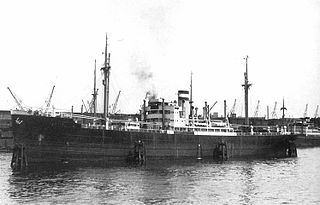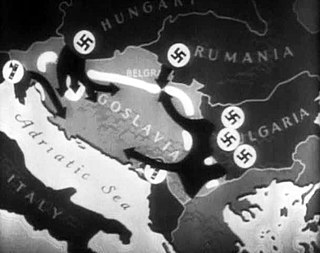Related Research Articles
The German operation for the invasion of Denmark and Norway in April 1940 was code-named Weserübung, or "Weser Exercise." Opposing the invasion were the partially mobilized Norwegian military, and an allied expeditionary force composed of British, French, and Free Polish formations. The following list formed the order of battle for this campaign.
The 1st Army was a Royal Yugoslav Army formation commanded by Armijski đeneral Milan Rađenković during the German-led Axis invasion of the Kingdom of Yugoslavia in April 1941 during World War II. It consisted of one infantry division, one horsed cavalry division, and two brigade-strength infantry detachments. It formed part of the 2nd Army Group, and was responsible for the defence of the section of the Yugoslav-Hungarian border between the Danube and the Tisza rivers.

Edvard Apolloniussen Liljedahl was a Norwegian politician for the Liberal Party. He was a member of the Council of State Division in Stockholm in 1889, and Minister of Education and Church Affairs in 1912-1913. Liljedahl died on 10 October 1924 in Vik and was buried there.

Sven Oftedal was a Norwegian physician and politician, representing the Labour Party. He was Minister of Social Affairs in 1945 and 1945-1948 and a member of the Storting (1945-1948).

The invasion of Yugoslavia, also known as the April War or Operation 25, was a German-led attack on the Kingdom of Yugoslavia by the Axis powers which began on 6 April 1941 during World War II. The order for the invasion was put forward in "Führer Directive No. 25", which Adolf Hitler issued on 27 March 1941, following a Yugoslav coup d'état that overthrew the pro-Axis government.
Einar Osland was a Norwegian politician for the Liberal Party.
The 101st Jäger Division was a light infantry Division of the German Army in World War II. It was formed in July 1942 by the redesignation of the 101st (Light) Infantry Division, which was itself formed in December 1940. The Walloon Legion was briefly attached to this division from December 1941 to January 1942. The Division took part in the Battle of Kharkov, the Battle of the Caucasus, and the retreat into the Kuban, where it suffered heavy losses fighting both the Red Army and partisans. The division was then involved in the battles in the Kuban bridgehead before being evacuated. The 101st was subsequently transferred to the lower Dnieper River in late 1943. It was part of the 1st Panzer Army that was surrounded in March 1944; it formed the rear guard for the XLVI Panzer Corps during the breakout of the Kamenets-Podolsky pocket. The division then retreated across Ukraine. In October 1944, it was moved to Slovakia and took part in the Battle of the Dukla Pass.

MSPalatia was a German cargo liner, built in 1928. After serving for several years on the Hamburg America Line's route to the Caribbean, she was sold to the Soviet Union in 1940. Following the outbreak of war between Nazi Germany and the Soviet Union in June 1941, she was captured by the Germans and pressed into Kriegsmarine service.

Nils Olav Young Fearnley was a Norwegian businessperson and landowner.
The 1st Division is a former unit in the Norwegian Army, responsible for the defence of Eastern Norway along with 2nd Division.
Arnt Jacobsen Mørland was a Norwegian ship-owner, resistance member, and politician for the Christian Democratic Party.
Edvard Christian Danielsen was a Norwegian naval officer. He held the rank of Vice admiral in the Royal Norwegian Navy and was chief of the admiral staff in London during World War II.

The Axis order of battle for the invasion of Yugoslavia was made up of the various operational formations of the German Wehrmacht and Waffen-SS, Italian Armed Forces and Hungarian Armed Forces that participated in the invasion of Yugoslavia during World War II, commencing on 6 April 1941. It involved the German 2nd Army, with elements of the 12th Army and a panzer group combined with overwhelming Luftwaffe support. The eighteen German divisions included five panzer divisions, two motorised infantry divisions and two mountain divisions. The German force also included two well-equipped independent motorised regiments and was supported by over 800 aircraft. The Italian 2nd Army and 9th Army committed a total of 22 divisions, and the Royal Italian Air Force had over 650 aircraft available to support the invasion. The Hungarian 3rd Army also participated, with support from the Royal Hungarian Air Force.
The 2nd Army Group was a Royal Yugoslav Army formation commanded by Armijski đeneral Milutin Nedić during the German-led Axis invasion of the Kingdom of Yugoslavia in April 1941 during World War II. It consisted of the 1st and 2nd Armies, comprising four infantry divisions, one horsed cavalry division, two brigade-strength infantry detachments, and one horsed cavalry regiment. It was responsible for the defence of the border with Hungary from Slatina to the Tisza river.

The 2nd Army was a Royal Yugoslav Army formation commanded by Armijski đeneral Dragoslav Miljković that opposed the German-led Axis invasion of the Kingdom of Yugoslavia in April 1941 during World War II. It consisted of three infantry divisions and one horsed cavalry regiment along with supporting units. It formed part of the 2nd Army Group, and was responsible for the defence of the Yugoslav–Hungarian border along the Drava river from Slatina to the Danube.
The 3rd Army was a Royal Yugoslav Army formation commanded by Armijski đeneral Ilija Brašić during the German-led Axis invasion of the Kingdom of Yugoslavia in April 1941 during World War II. It consisted of two reinforced infantry divisions, two infantry divisions, and a brigade-strength horsed cavalry detachment. It formed part of the 3rd Army Group, and was responsible for the Yugoslav-Albania border between Lake Ohrid and Lake Skadar.

The 32nd Infantry Division Triglavski was a short-lived Royal Yugoslav Army infantry formation raised prior to the German-led Axis invasion of the Kingdom of Yugoslavia in April 1941. It was largely mobilised from the Dravska military district, and, like all Yugoslav infantry divisions of the time, was a very large and unwieldy formation which was almost entirely reliant on animal transport for mobility. Commanded by Divizijski đeneral Dragiša Pandurović and largely manned by Slovene troops, the division also lacked modern arms and sufficient ammunition.
John Norem was a Norwegian barrister and politician. He was a member of the Storting from 1925 to 1933, and County Governor of Rogaland from 1933 to 1958.
Einar Jørgensen was a Norwegian military officer, teacher and politician.
Einar Liljedahl was a Norwegian military officer.
References
- ↑ Faye, Wilhelm (1953). Krigen i Norge 1940. Operasjonene i Kristiansand–Setesdals-avsnittet (in Norwegian). Forsvarets Krigshistoriske Avdeling / Gyldendal. pp. 15–26, 192–198 215.
- ↑ Rapport fra den militære undersøkelseskommisjon av 1946 (in Norwegian). pp. 84–92. Retrieved 7 October 2018.
- ↑ Niehorster, Dr Leo. "3rd Division, Royal Norwegian Army, 8.04.1940". niehorster.org. Retrieved 2023-05-14.
- ↑ Gram, Harald; Steenstrup, Bjørn, eds. (1948). "Liljedahl Einar". Hvem er hvem? (in Norwegian). Oslo: Aschehoug. p. 322. Retrieved 7 October 2018.